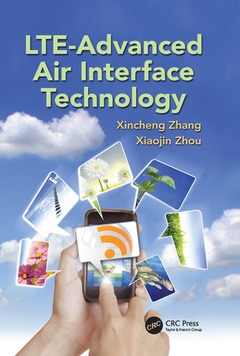Description
LTE-Advanced Air Interface Technology
Authors: Zhang Xincheng, Zhou Xiaojin
Language: English
Subjects for LTE-Advanced Air Interface Technology:
Keywords
Intercell Interference; RN; From LTE to LTE-A; CCs; Carrier Aggregation; ICIC; Collaborative Multipoint; Intercell Interference Coordination; Self-Organizing Network; LTE Rel-8; Heterogeneous Networks; Antenna Ports; Precoding Matrix; SM; DMRS; Channel Estimation; Transmit Antennas; Serving Cell; Crs; Channel State Information; UL Grant; RRC Connection; Radio Bearer; HARQ Process; Backhaul Link; Dl Subframe; IC; CA; Low Power Nodes; Codebook Design
Publication date: 10-2016
· 15.6x23.4 cm · Paperback
Publication date: 09-2012
528 p. · 15.6x23.4 cm · Hardback
Description
/li>Contents
/li>Readership
/li>Biography
/li>
Opportunities are at hand for professionals eager to learn and apply the latest theories and practices in air interface technologies. Written by experienced researchers and professionals, LTE-Advanced Air Interface Technology thoroughly covers the performance targets and technology components studied by 3GPP for LTE-Advanced. Besides being an explanatory text about LTE-Advanced air interface technology, this book exploits the technical details in the 3GPP specification, and explains the motivation and implication behind the specifications.
After a general description of wireless cellular technology evolution and the performance targets and major technical features of LTE-Advanced, LTE-Advanced Air Interface Technology discusses various innovative technical features in detail, including
- Innovative concepts in carrier aggregation techniques
- Collaborative multipoint (CoMP) theory and performance analysis
- Enhanced multiantenna solutions or multiple-input, multiple-output (MIMO) technology, in particular, multiuser and multilayer MIMO
- Relaying issues
- Self-organizing and heterogeneous networks
- Interference suppression and enhanced intercell interference coordination (eICIC) technology
This book opens the door of LTE-A technology for practitioners in any stage of wireless communications. Beginning with basic communication principles, the book demonstrates how a complete wireless theory is built. Readers can work independently on original case studies and simulation programming examples, with an emphasis on technology and performance. Designed for professionals interested in gaining an upper hand, this book is the ideal educational and informative resource in the emerging field of air interface technology.
From LTE to LTE-A: Review of LTE. Performance Targets of LTE-A. LTE-A Technologies. Carrier Aggregation: Basic Concepts of CA. CA Configurations. CA Layer 2 Structure. DL CA Operations. UL CA Operations. CA Scheduling. RRM and Mobility. RF Consideration for CA. Collaborative Multipoint: General Description. CoMP Technology. Reference Signal Design. CoMP Feedback. DL CoMP. UL CoMP. CoMP Limitation. CoMP Performance. MIMO: Wireless Channel Characteristics. Overview of MIMO. DL MIMO. UL MIMO. Multiuser MIMO. Cooperative MIMO. Beamforming and DL Dual-Stream Technology. Relaying: Relay Technology. Relay Architecture. Relay Radio Protocol. Relay Performance Analysis. Relay Evolution. Self-Organizing Network: Self-Configuration. Self-Optimization. Self-Healing. SON Outlook. Heterogeneous Networks: Features of the Heterogeneous Network. Heterogeneous Network Combined with Cloud RAN. Radio Strategy.
Xincheng Zhang graduated from Beijing University of Posts and Telecommunications (Beijing, China) in 1992. He has been working for China Mobile for 20 years as a technical expert with a solid understanding of wireless communication technologies. He is working as a senior wireless network specialist in the fields of antenna arrays, analog/digital signal processing, radio resource management, propagation modeling, and so on. He has participated in many large-scale wireless communication system designs for a variety of cellular systems using various radio access technologies, including the Global System for Mobile Communication (GSM), Code Division Multiple Access (CDMA), Universal Mobile Telecommunications System (UMTS), and Long Term Evolution (LTE). He is the author or coauthor of eight books on Wideband Code Division Multiple Access (WCDMA), Worldwide.
Xiaojin Zhou received his first master’s degree in electronic and information engineering from Beijing University of Posts and Telecommunications (Beijing, China), and his second master’s degree in the engineering management program from the University of Ottawa (Ottawa, Canada). He has worked for China Mobile for many years, and has extensive knowledge on wireless communication systems and data communication networks. He now works for Ericsson, which he joined in 2008, and is actively participating in leading-edge LTE product design and implementation. He is the coauthor of several books on wireless technologies, including WiMAX and LTE.




